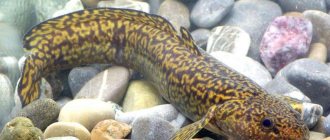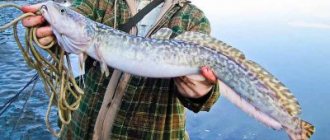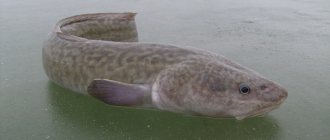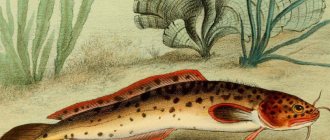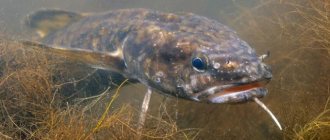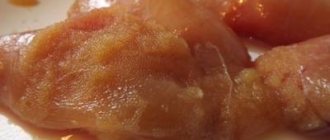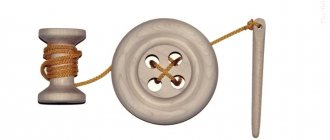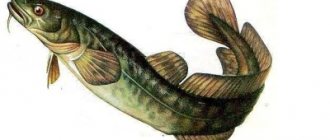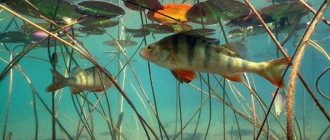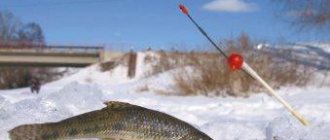Burbot behavior
Burbot is the only freshwater fish of the cod order. It has an elongated body resembling an eel, the head is somewhat similar to a catfish. The burbot has a large mouth and a spotted coat, the color of which depends on the type of body of water in which it lives. The burbot itself moves along the bottom using the same route.
It’s a paradox, but a fact: weak fires attract burbot. It is not known what exactly attracts him to swim to the surface, the sound of the sound of tossed pieces of wood or the play of the fire itself, but it is so.
Burbot is extremely cold-loving. It makes sense to catch him only at night, because during the day he will never make a move. Its spawning lasts from the beginning to the end of winter, that is, from December to February. It goes hunting exclusively at night, when other fish are not active. Good fishing with worms and lampreys. It is active mainly from the beginning of autumn to the beginning (sometimes mid) of December, and after spawning (late February - early March) it is especially active and voracious. At this time, it enters riffles 1.4-3.2 meters deep.
Under no circumstances should you shine a flashlight into the water; this will scare away the burbot. His eyes are adapted for the night, the light cuts them.
Fish value
Burbot is a valuable commercial fish with good gastronomic qualities. From it you can prepare a variety of dishes with a memorable taste. The caught predator is fried, smoked, and stewed. Soups and broths are cooked from it, cutlets and meatballs are made.
We recommend reading: Winter bream fishing with a combine harvester
Taste qualities
Among those who understand, burbot is considered a desirable fish. Fresh pulp has a pleasant sweetish taste and delicate texture.
On a note! In terms of taste, burbot meat is not inferior to marine representatives of the cod fish family - navaga, cod, molva, pollock, and mink. However, if the caught predator had to be put in the freezer, then after defrosting it becomes almost tasteless, acquires a fibrous structure and loses juices.
The fish has practically no small bones that cause inconvenience to the cook. It is usually not necessary to clean the carcass from dense scales. It is better to remove the head and throw it away, but the liver, caviar and milt, on the contrary, are of increased gastronomic interest.
Composition and calorie content
Burbot meat has a low calorie content, only 80 kcal per 100 grams of product. Protein is 18.8 g, and fat is only 0.6 g. It contains many useful microelements:
- zinc;
- manganese;
- iron;
- iodine;
- selenium;
- copper.
The meat contains vitamins A, D, E, B1, B6, B12.
What are the benefits of burbot for humans?
The meat of this representative of the ichthyofauna is indicated for people who adhere to a low-calorie diet. It is included in the weight loss menu. In addition, it is used in the diet of people diagnosed with heart disease and atherosclerosis.
Fish is good for children and teenagers. Burbot meat helps prevent ophthalmic diseases, increases the absorption of calcium by the body and tissue regeneration in case of injury. The vitamins contained in it affect the mental development of the child.
Contraindications
Burbot has no special restrictions on its use. It should not be eaten by persons:
- with allergic reactions to fish;
- in the presence of stones in the kidneys and gall bladder;
- with a high content of vitamins D in the body;
- with hypercalcemia.
In other cases, you should not limit yourself to consuming this predator.
Where to catch burbot
Burbot is a northern fish, which is caught in the CIS mainly in northern rivers, in many European countries, with the exception of England, Spain, Belgium and other southern countries. However, it is gradually disappearing as a species, and only in Switzerland is it abundant. There is also a lot of it in North America, in particular in Alaska and Canada.
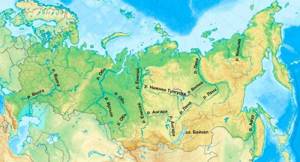
In all northern parts of these rivers you can catch burbot, perhaps except for the Volga (with the exception of a couple of places)
Burbot is caught at low water temperatures (no higher than 12-14 degrees Celsius) in river mouths, in freshwater places rich in oxygen. Burbot avoids snags, algae, thickets, all kinds of fallen trees and other obstacles. He prefers rivers with weak currents, open places and the deepest holes. He feels as comfortable as possible in them. Also during zhora (before winter) it lives in riffles 1.5-3 m deep. Burbot prefers rocky and sandy bottoms, but can sometimes be found on muddy ones.
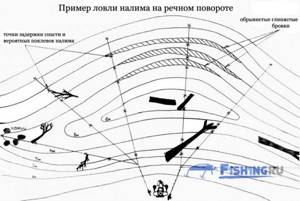
Burbot rarely gathers in schools, preferring to act alone. Therefore, finding a parking lot is a great success. Such sites are usually 16-25 meters in diameter. Peat bogs are a good sign when hunting for this predator, but it does not live directly in them, but nearby, downstream from them, at a depth of about 3 meters. A spring is also an excellent sign; burbot loves places rich in oxygen, especially clean water.
Leningrad, Moscow region and others
The rivers Pechora, Ob, Irtysh, Vilyui, Lena are especially rich in burbot. In general, northern rivers are the main habitat of burbot, and the further west and south you go, the less chance you have of finding it. Also the Yenisei, Lower Tunguska and their tributaries.

Click to enlarge
In the Leningrad region, burbot can be found in the Gulf of Finland, the Neva River basin - small individuals can be found near sharp cliffs, and medium-sized ones (over 1000 grams) 10-15 meters from the shore. When fishing on the Neva within the city limits, do not expect large specimens; you will be lucky if the weight of the burbot is about 1200 grams. Also in the Leningrad region, burbot bite well on the Pasha and Vuoksa rivers (Burnaya, Sukhodolskoye) , but this is more likely Karelia . Closer to the city of St. Petersburg itself, it is caught in Otradnoe (and higher). Burbot was also seen in Sestroretsk , Gremuchiy , dam on Volkhov , on Burnaya , near the confluence of the Vyun, Ladoga, Svir, Onega rivers.
Where burbot lives in the Moscow region (Moscow region) is the Klyazma , the Sherna (Karavaevo). Dubna is a science city located in the north of the Moscow region, in the Volga , but you can only fish 1 km from the dam, otherwise there is a chance of getting a fine. This is probably the only place that exists as an exception to the rule that there are no burbot in the rivers flowing into the Black and Caspian Seas.
On the Oka - in Velegozh , pl. 107 km . (train station). Polenovo, Sknizhka River (a tributary of the Oka, not to be confused with Skniga). Luzhki , Kashirskaya State District Power Plant . Above the village of Baskachi there is a place with deep holes where burbot and catfish are consistently caught. Fishing on the right side, but easiest to find with an echo sounder. It also bites above Serpukhov (you can try below). There are also many catchable places where the Mutenka flows into the Oka.
But remember that on the Oka you are unlikely to be able to catch a burbot larger than 800 grams.
Interesting Facts
Burbot is a unique species, which in its habits and way of life is very different from other representatives of the ichthyofauna:
- It spawns in winter, when the water temperature drops to 1–3 degrees. At the same time, all other fish become sluggish and passive, but this predator comes to life, feeds heavily, and migrates to spawning areas.
- Goes out hunting at night. In this it is similar to catfish and pike perch. In cloudy weather it can feed during the day.
- Males participate in spawning annually. After spawning, females take a break of 1-2 seasons to recuperate.
- Very prolific. They can lay up to a million eggs per meal.
- Cannibal. Willingly eats its eggs and one-year-old juveniles.
- The pelvic fins, located under the throat, have many small papillae that act as taste buds. This explains why the predator moves along the very bottom, periodically touching it.
- The liver in burbot is highly valued. It is nutritious and non-greasy. Its weight is 8–9% of the total mass of the individual.
We recommend reading: Catching perch on the first ice with a jig
This species is loved all over the world. For example, in Alaska it is called the "poor man's lobster." We use it to prepare a variety of dishes that are appreciated by all gourmets.
Is burbot a scavenger?
This predatory fish does not disdain carrion. Despite the fact that her diet contains enough live food, she will not swim past a dead carcass or other easily accessible food found at the bottom. That’s why it is often caught on sleeping fry, pieces of meat and lard, liver and offal, defrosted sprat and shrimp are hooked.
How to determine the age of burbot
The main characteristic by which ichthyologists can determine important information about a fish is the size of its scales. But for burbot it does not record the age code. How old the predator is in this situation can be understood by looking at the otoliths - special auditory capsules located in its braincase.
The sizes of otoliths vary between species. Therefore, only ichthyologists and biologists can accurately understand how long the fish lived. An amateur fisherman will not determine the age of a predator on his own. You can only roughly estimate this characteristic by measuring the length and weighing the individual.
Commercial significance
Commercial fishing for burbot is permitted only in the northern regions and only with nets. He is hunted in the Lena, Yenisei, and Ob basins. They fish on the very beds of rivers, in floodplain lakes, reservoirs, numerous channels, and deep pools.
For reference: In the Yenisei basin, burbot catches account for 5–6% of the total annual fish production.
Recreational fishing is allowed in many regions of our country. The best time to fish for a predator is winter. They catch with donks, girders, hooks, and snookers, setting up gear early in the morning, at dusk, or leaving it overnight.
Size of burbot allowed to be caught
In those regions where burbot fishing is allowed, minimum sizes for fishing have been established. For example, in many regions you can pick up specimens whose length exceeds 40 cm, in the northern regions - 45 cm, in the Republic of Belarus there is a limit of 36 cm.
In any case, when going to a reservoir, it would be useful to inquire about the minimum size of fish allowed for catching in a particular region. You can turn to thematic resources or social networks, search the Internet for fishing rules, call or go to local fisheries authorities.
What to fish with
In autumn and early spring, burbot is caught using donks or half-bottoms. As bait they use worms, which burbot loves very much, fry, perch and ruffe, bird liver (chicken liver is fine), crawlies, pieces of fish.
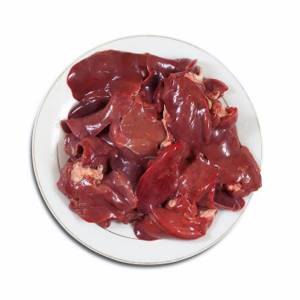
Even rotten bird liver is suitable; the strong smell will attract burbot

The crawler is a type of annelid worm. At night he (!) crawls out, which is very useful when fishing for burbot at night
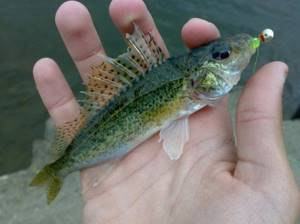
The ruff is very tenacious, so when fishing with a donk, one individual can be used several times in a row.
Important! If you are fishing with live bait, it must be caught in the same body of water in which you are going to catch the burbot. Otherwise, the chance of a bite is sharply reduced.
Spinners for burbot
In winter, burbot is caught using bait baits and simple winter fishing rods using spinners. For burbot, there are special spinners that make a sound that attracts burbot. The nature of this phenomenon is unclear, but it really works. We have a separate article on winter fishing for burbot using snookers. Also, according to this article, you can even make such a spinner with your own hands.
When fishing with live bait, flags are traditionally used - bite alarms.
⚓ Where and when does the predator feed
In November, the burbot's diet consists mainly of small fish, which hide from the cold in bottom depressions. Here the predator feasts on it with great pleasure. Forage fish also like to gather near small tributaries with little current, where the depth does not exceed 2 meters. On lakes, in conditions of standing water, its favorite place is the shore edges. It is in such places that burbot fatten up before spawning, emerging from deep holes and snags.
In wide, fast rivers, this predator can be found in coastal areas with the so-called reverse current. Small fish also gather here. The most catchy point is considered to be the border between calm water and fast flow. As a rule, the depth in such places is 1.5-2 meters.
It is important to know that burbot, unlike most other species, is not happy with bottom vegetation. In addition, it avoids heavily silted areas of the river, so you should not fish where the bottom is soft and water lilies or other aquatic plants grow densely in summer.

An echo sounder will help you find prey. Unfortunately, it will not show where the fish are located, since active burbot does not stand in one place, but with its help you can detect promising edges, depressions and protrusions on the bottom surface. Sometimes before the first bite you have to make more than one cast to different depths, but when you manage to find a point (burbot trail), fishing becomes interesting and exciting.
What time does the fish bite? If the weather is cloudy or drizzling, bites are possible during the daytime, but a better solution would be to go to the pond at night. Burbot is a nocturnal predator; it begins to feed intensively after sunset. It is important to understand how cold the November nights can be and dress accordingly, otherwise you will have to sit in the car for the entire fishing trip.

Collecting gear for catching burbot in the fall
The best method for catching cod in fresh water is feeder or bottom gear. They will be formed approximately the same, and the gear will allow for more active burbot fishing on the Irtysh and other rivers.
Tackle for catching burbot almost always has the following composition:
- a sinker is attached to the end of the base;
- A leash with a hook is tied about a meter before the load.
This is how blind equipment is assembled, but experienced fishermen recommend making equipment with a sliding weight. To do this, the base of the tackle is threaded through the sinker, and a stopper is placed before and after it. Next, they knit a leash with a hook; this method will help to detect well not only burbot, but also other representatives of the animal world of the selected reservoir.

